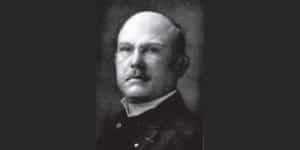Michael Porter biography, quotes and books

Michael E. Porter (1947) is a professor and management guru in the field of competitive strategy and the Bishop William Lawrence University Professor at Harvard Business School (HBS). Michael Porter is known for his various management books and theories like i.e. the Five Forces Model, his Diamond model and the generic strategies.
The biography of Michael Porter
Michael Porter was born in Ann Arbor, Michigan. His father was a civil engineer and Georgia Tec institute graduate who joined the army to become an army officer.
Education
He studied at the Princeton University (MSc.) and obtained his doctorate (Ph.D.) in Business Economics from Harvard University in the United States in 1973.
Aside from being a professor at Harvard Business School, Michael is also the director of the school’s Institute for Strategy and Competitiveness, which was founded in 2001 to further his work and research.
Porter is the author of famous management books such as Competitive Strategy (1980), Competitive Advantage (1985), Competition in Global industries (1986) and The Competitive Advantage of Nations (1990). These publications are all best-selling books and have made him world-famous in the field of competitive and business strategy.
The power of Michael Porter ’s publications lies in their practical character. Porter ’s publications provide entrepreneurs with extensive guidelines for obtaining better operating results.
Scientific Research and the development of Strategic Management theory
Michael Porter ’s early work was on industry competition and company strategy, and later turned to economic development and competitiveness. His work focused on the microeconomic underpinnings of national and regional economic development, of which his book ‘The Competitive Advantage of Nations’ was the initial foundation.
Not much later, in the early 1990’s, Porter proposed the “Porter Hypothesis” in environmental policy, which argued that strict environmental standards do not have to be in conflict with company profitability or national competitiveness, but could enhance both.
The Competitive Forces Model (or ‘Five Forces Model’), the Value Chain Model, the Porter diamond model and the theories on generic strategies that were developed by Michael Porter are known worldwide at every level of management.
Since the early 2000s, Michael focused on the economics of health care, with a goal of realigning health care delivery to maximize value to patients. This work is also known as Porter’s Value-Based Health Care Delivery framework.
Also Management Consultancy
In addition to doing scientific research, writing and teaching work, Michael Porter is also a consultant in the corporate world. In addition to various government bodies and the social sector. He works as a strategy specialist at several large companies, including Proctor & Gamble, Caterpillar and Royal Dutch Shell.
From 2009 he also advised the presidents of Rwanda and South Korea.
His contribution to Non-profit
Michael Porter has (co-)founded several non-profit organizations:
- Initiative for a Competitive Inner City (ICIC)
- Center for Effective Philanthropy (CEP)
- FSG
- International Consortium for Health Outcomes Measurement (ICHOM)
ICIC addresses economic development in distressed urban communities and CEP creates tools for measuring foundation effectiveness. FSG is a non-profit strategy firm that conducts research and advises on improving social value creation. ICHOM supports the strategic agenda of Porter’s Value-Based Health Care Delivery framework.
Famous quotes by Michael Porter
- “Innovation is the central issue in economic prosperity.”
- “The best CEO’s I know are teachers, and at the core of what they teach is strategy.”
- “The essence of strategy is choosing what not to do.”
- “The company without a strategy is willing to try anything.”
- “If all you’re trying to do is essentially the same thing as your rivals, then it’s unlikely that you’ll be very successful.”
- “Finally, strategy must have continuity. It can’t be constantly reinvented.”
- “Strategy 101 is about choices: You can’t be all things to all people.”
- “The essence of strategy is that you must set limits on what you’re trying to accomplish.”
- “Companies operating in urban communities have a tremendous ripple effect.”
- “Good leaders need a positive agenda, not just an agenda of dealing with crisis.”
Books and Publications by Michael Porter
- 2011. Creating shared value. Harvard business review, 89(1/2), 62-77.
- 2011, 1990. Competitive advantage of nations: creating and sustaining superior performance. Simon and Schuster.
- 2008. On competition. Harvard Business Press.
- 2008. The five competitive forces that shape strategy. Harvard business review, 86(1), 25-40.
- 2008. Competitive strategy: Techniques for analyzing industries and competitors. Simon and Schuster.
- 2006. Redefining health care: creating value-based competition on results. Harvard Business Press.
- 2003. The Economic Performance of Regions, Journal: Regional Studies – REG STUD , vol. 37, no. 6-7, pp. 545-546.
- 2002. The determinants of national innovative capacity, Journal: Research Policy – RES POLICY , vol. 31, no. 6, pp. 899-933.
- 2002. The competitive advantage of corporate philanthropy. Harvard business review, 80(12), 56-68.
- 2002. The determinants of national innovative capacity. Research policy, 31(6), 899-933.
- 2001. Strategy and the Internet. Harvard business review, 79(3), 62-79.
- 2000. Location, Competition, and Economic Development: Local Clusters in a Global Economy, Journal: Economic Development Quarterly – ECON DEV Q, vol. 14, no. 1, pp. 15-34.
- 1998. Clusters and the new economics of competition (Vol. 76, No. 6, pp. 77-90). Boston: Harvard Business Review.
- 1998. Clusters and competition: New agendas for companies, governments, and institutions (pp. 197-287). Boston: Harvard Business School Press.
- 1998, 1985. Competitive advantage: creating and sustaining superior performance. FreePress.
- 1997. How much does industry matter, really?.
- 1997. Competitive Strategy, Journal: Measuring Business Excellence , vol. 1, no. 2, pp. 12-17.
- 1996. What is strategy?. Published November.
- 1996. Competitive advantage, agglomeration economies, and regional policy. International regional science review, 19(1-2), 85-90.
- 1995. Green and competitive: ending the stalemate. Reader In Business And The Environment, 61.
- 1995. Toward a new conception of the environment-competitiveness relationship. The journal of economic perspectives, 97-118.
- 1995. The competitive advantage of the inner city. The city reader, 274-286.
- 1994. The Role of Location in Competition, International Journal of The Economics of Business , vol. 1, no. 1, pp. 35-40.
- 1992. Capital choices: Changing the way America invests in industry. Journal of Applied Corporate Finance, 5(2), 4-16.
- 1991. Strategy: Seeking and Securing Competitive Advantage. Harvard Business Review Press.
- 1991. Towards a dynamic theory of strategy. Strategic management journal, 12(S2), 95-117.
- 1991. Capital disadvantage: America’s failing capital investment system. Harvard business review, 70(5), 65-82.
- 1991. Towards a dynamic theory of strategy, Journal: Strategic Management Journal – STRATEG MANAGE J , vol. 12, no. S2, pp. 95-117.
- 1990. Competitive Advantage of Nations, Journal: Competitive Intelligence Review , vol. 1, no. 1, pp. 14-14.
- 1987. From competitive advantage to corporate strategy (Vol. 59). Cambridge, MA: Harvard Business Review.
- 1986. Competition in global industries. Harvard Business Press.
- 1986. Coalitions and global strategy. Competition in global industries, 1(10), 315-343.
- 1986. Changing patterns of international competition, Journal: The International Executive, vol. 28, no. 2, pp. 13-14.
- 1985. How information gives you competitive advantage.
- 1982. Business policy: Text and cases (p. 7). RD Irwin.
- 1981. The contributions of industrial organization to strategic management. Academy of management review, 6(4), 609-620.
- 1980. Competitive Strategy: Techniques for Analyzing Industries and Competitors. Free Press.
- 1979. The structure within industries and companies’ performance. The review of economics and statistics, 214-227.
- 1979. How competitive forces shape strategy (pp. 21-38). Boston: Harvard Business Review.
- 1985. How Information Gives You Competitive Advantage.
- 1979. The Structure within Industries and Companies Performance.
- 1979. How Competitive Forces Shape Strategy. Harvard Business Review.
- 1977. From entry barriers to mobility barriers: Conjectural decisions and contrived deterrence to new competition. The Quarterly Journal of Economics, 241-261.
How to cite this article:
Van Vliet, V. (2009). Michael Porter. Retrieved [insert date] from Toolshero: https://www.toolshero.com/toolsheroes/michael-porter/
Published on: 08/12/2009 | Last update: 03/25/2023
Add a link to this page on your website:
<a href=”https://www.toolshero.com/toolsheroes/michael-porter/”>Toolshero: Michael Porter</a>











